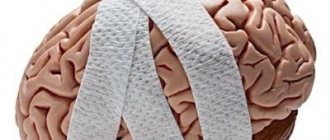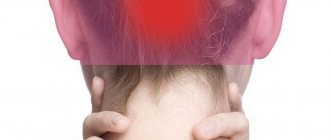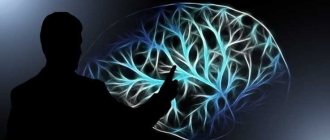Amnesia is a memory disorder characterized by loss of information about an event or action. Such disorders occur in people of any age for various reasons. Retrograde amnesia is characterized by the loss of memories that precede mental pathology or unconsciousness. The disorder is diagnosed by a psychiatrist. He examines the patient and identifies possible causes of memory impairment. Therapy is aimed at eliminating the consequences of the primary disease and improving brain function with the help of medications and psychotherapy.
Diagnostics
When determining the state of the brain and the cause of retrograde amnesia, the doctor finds out in detail what preceded the memory loss.
There is often a clear correlation with trauma, a major stressful event, illness, substance use, or other factor. To clarify all the circumstances, a conversation with relatives is important. The nature of memory loss becomes clear during a conversation with the patient. Detailed diagnosis of all memory characteristics is carried out using neuropsychological and pathopsychological examination methods. Typically this is done by a clinical psychologist. Retrograde amnesia in psychology is considered as part of a complex of cognitive changes. Thinking and perception are always explored simultaneously. This approach gives a general idea of the changes and helps make a prognosis for the patient.
Instrumental examination methods make it possible to determine whether there are changes in brain tissue that could affect memory. This will also make it clear whether the memory loss will be permanent.
- Dopplerography helps to find out the characteristics of blood circulation in the brain.
- An echoEG is prescribed if there is a suspicion of a tumor in the brain, a scar, or tissue thinning. Most often, this method is used if it is not possible to conduct an MRI, or it is necessary to supplement its data.
- An EEG establishes the functional activity of the brain by detecting electrical activity. This gives an idea of how active the affected area of the brain is.
- MRI provides comprehensive data on the structure and individual anatomical features of the brain, and allows you to determine the thickness of the cortex in areas of interest to the doctor. This gives an idea of the nature of the injury or other damage and helps make a prognosis.
Based on all the examination data, the doctor can prescribe treatment.
Impact on culture
Amnesia is often used as a plot device in works of fiction. The vast majority of cases describe retrograde amnesia. As a rule, portrayals of amnesia in films and fiction are unreliable: the hero loses memories of his personality, but retains skills and the ability to communicate.
Rare examples of characters with more or less reliably shown anterograde amnesia are the main character of the film “Memento” and Dory the fish in the cartoons “Finding Nemo” and “Finding Dory”. The melodrama “50 First Dates” also shows anterograde amnesia, but, according to experts, it is unreliable.
Movies:
- Who am I? (1998)
- Remember (2000)
- Inside My Memory (2003)
- Deja Vu (1989)
- 50 First Dates (2004)
- Man Without a Past (2002)
- The Bourne Identity (2002)
Anime:
- Ergo Proxy (2006)
- Ef: A Tale of Memories (2006)
- Tasogare Otome x Amnesia (2008)
- Golden Time (2010)
Manga:
JoJo's Bizarre Adventure: Jojolion (2011 - present)
Video games:
- Arx Fatalis (2002)
- XIII (game) (2003)
- Second Sight (2004)
- Shadow The Hedgehog (2005)
- The Witcher (2007)
- The Witcher 2: Assassins of Kings (2011)
- Amnesia: The Dark Descent (2010)
- Amnesia: A Machine for Pigs (2013)
Classification by dynamics
Judging by how long it lasts and at what point the period of forgetting occurs, there are:
- Progressive amnesia. Events and memories disappear gradually and sequentially, one after another. The most recent ones are erased first, then the older ones.
The carrier of the disease cannot accurately remember what he did yesterday, last year or in childhood. The chronological map becomes confused, and the person suffering from this disorder loses orientation in time and space. This is often a consequence of mental illness in old age.A person exists among fragments of ancient and recent circumstances, places, actions, impressions. With such a disorder, only part of reality can be recorded. The cerebral cortex is destroyed, and the disease constantly progresses.
Retarded amnesia. It is also called “delayed” or “delayed”, since forgetting occurs some time after the loss of consciousness, the stage of psychosis, and confusion occurs.
Having come to his senses, the patient can even share his impressions of what he felt, and as time passes, he can completely forget about what happened.
Stationary. Specific events are blocked and cannot be resurrected. Forgetting is persistent, it does not extend to other events or circumstances, no dynamics are observed.
Regressive. A fairly common occurrence under severe stress. Unlike progressive amnesia, this type is characterized by the return of the forgotten. Lost memories can be fully recovered over time. Considered a temporary loss of information. Failures can happen to people of any age.
Causes of amnesia in young people
You can often hear stories about how a young, healthy man left the house in home clothes and slippers and did not return. What happened, why did the man get lost?
The young man could have been attacked by bandits, asking for a light, or hit on the head with brass knuckles or a stone. After an injury, all memories may disappear from the head. Even minor concussions cause short-term forgetfulness. But soon the memories will be restored and the victim will return home.
After a stroke, people of working age experience:
- dizziness;
- severe pain in the head;
- memory loss;
- blurred vision;
- sensory disturbance;
- partial or complete paralysis;
- loss of balance;
- the smile becomes asymmetrical;
- difficult to speak the language.
From the editor: Methods for developing memory in children of different ages
After drinking alcohol the night before, it may be impossible to remember what happened after drinking. It is difficult to determine a dangerous dose. It all depends on the person’s well-being, weight, gender and what he ate before drinking. Alcohol, drunk on an empty stomach, is absorbed instantly and has a strong toxic effect.
Recently, more and more often there are people who have lost their memory of who they are, what food and people are, for no apparent reason, between the ages of 17 and 60 years. Once in the hospital, they remain “zombies” for a long time and learn all life skills again.
Scientists suggest that these people are influenced by an external influence. A person without memory can be used as an unpaid worker, an executive killer. Memory may not return to such people at all or after a long time.
Often “zombies” do not remember who they are, but retain their professional skills. This leads scientists to believe that they were used as intellectual slaves. Relatives must look for their loved ones and help them return to normal life.
Causes
A temporary form of anterograde amnesia can occur for various reasons.
Organic causes
Pathology can develop due to cerebral circulation disorders due to head injuries or traumatic brain injuries or operations.
Memory disorders can also appear in a person who has suffered an infectious disease, after which complications arose.
Psychological reasons
The occurrence of anterograde amnesia is typical after prolonged stress, excessive nervous tension, or severe fright. May develop in people with depression. Occurs with epilepsy, mental retardation. Possible development due to psychosomatic diseases.
Taking medications
Long-term use of certain medications can also cause problems. Amnesia can develop due to the use of tranquilizers and sleeping pills. In addition, drugs, alcoholic beverages, and toxic chemicals pose a danger: their constant use can cause the development of memory disorders.
Memory loss after alcohol
It is believed that even at the first stage of alcohol dependence, amnesia may occur. Sudden amnesia due to excessive alcoholic libation becomes stressful for the individual. However, not everyone experiences memory loss after drinking alcoholic liquids. For temporary amnesia to occur, it is necessary to “comply” with the following conditions: the number of drinks consumed, the degree of alcohol, the simultaneous consumption of a variety of alcoholic beverages, drinking alcohol on an empty stomach, the combination of alcoholic beverages with medications.
From the editor: What is the name of the disease in which you forget everything?
How severely the connections between brain cells are damaged when drinking alcohol-containing liquids depends on the amount of ethyl alcohol that enters the body. It is believed that small doses of alcohol do not lead to loss of memories. However, the influence of alcoholic drinks on people is quite individual: firstly, the very concept of a small dose is different for different people, and secondly, the gender of the drinker, his age and general health are of great importance.
There is also a pattern: the higher the degree of alcoholic drink, the greater the likelihood that the drinking individual will have memory lapses.
The simultaneous consumption of different drinks containing different alcohols sharply increases the likelihood of amnesia.
Drinking on an empty stomach promotes instant absorption of liquid in the body, as a result of which almost all of the ethanol immediately enters the blood, which leads to rapid intoxication, which has the most destructive effect.
When drinking alcohol while undergoing drug treatment or combining the use of alcohol-containing liquids with drugs or smoking, the likelihood of amnesia increases several times.
Of the three types of memory, alcohol can only affect short-term memory; in other words, an individual’s memories “fall out” of a period of time.
Memory loss during alcohol intoxication occurs after palimpsest. A characteristic sign of the described condition is considered to be minor memory lapses, that is, the subject cannot remember some minor details or episodes of what happened during alcohol intoxication.
Memory loss in young people due to alcoholism occurs due to the occurrence of Wernicke-Korsakoff syndrome. This syndrome is observed when an individual’s body is exposed to prolonged intoxication in the absence of adequate nutrition and a lack of vitamins B and C.
Symptoms
The disease is characterized by the following symptoms:
- Forgetting events and information that were received at the beginning (immediately after surgery, a traumatic situation);
- a person can remember everything that happened earlier, before the illness, but the subsequent period is lost;
- mood swings, increased attempts to remember and reconstruct the chain of events;
- headaches;
- loss of concentration and confusion;
- confusion;
- loss of orientation in space;
- anxiety states (panic attacks, depressive disorders);
- problems with remembering and reproducing basic information (names, numbers, dates, recent events).
A person has difficulty in spatial orientation
He cannot concentrate on anything; it is difficult for him to remember the faces and names of loved ones. Often there is a replacement of real events with fictitious (false) events that never happened
With such symptoms, it is necessary to urgently begin treatment.
The duration of mild pathology is a couple of days or several months. In severe forms, such memory impairment can last for several years.4
Psychogenic and its types
Conditions when it is not possible to remember some part of the data relating to one’s own personality are called psychogenic amnesia. Their varieties:
- Catathymic amnesia. A person susceptible to this disorder forgets only those events, names, personalities, details that are unpleasant to him, which he encountered during psychological trauma. Can be diagnosed with psychogenic disorders. All events that coincide in time with the traumatic situation are also forgotten.
- Hysterical. Unlike catathymic, it allows the brain to retain memories of events that coincide in time with the traumatic ones, and only the immediate critical moment is forgotten. Refers to hysterical psychopathic syndrome.
Post-hypnotic. It is the only consciously induced memory loss. A person forgets events and actions that happened to him while he was under hypnosis. This is part of post-hypnotic suggestion.
Dissociative amnesia. The patient erases from his body personal information associated with severe stress, while retaining all other memories.
This is a kind of protective mechanism that allows the body to protect the psyche from destruction. The difference from the previous ones is that often the victim does not need treatment, and the process of forgetting itself is the treatment, that is, the brain protects its owner from unnecessary stress.
Dissociative fugue. This is also a certain protective mechanism, but it manifests itself in a different way. When placed in a devastating stressful situation, the subject literally wants to escape from it. This manifests itself in the form of a mental disorder, which is accompanied by an unexpected move and a complete inability to remember everything that concerns one’s own personality. Some time after the fugue, the patient remembers himself, but does not remember the events of this period.
The disease is extremely rare; its descriptions are found in both medical and fiction literature.
In young age
Memory deterioration in young people (18-30 years old) is often associated with the development of mental disorders that begin to manifest themselves at this age. Often the provoking factor, as with teenagers, is the bohemian and even to some extent dissolute lifestyle that they lead. Having escaped from the care of their parents, many lose control and turn to alcohol and drugs.
Brain, thinking, attention - intoxication negatively affects all these structures
Often at a young age, memory deteriorates due to traumatic factors: unsuccessful love relationships, divorce, problems with finding a job after graduation, conflicts with colleagues, etc.
Types of amnesia
- Retrograde amnesia
- the patient does not remember events that occurred before the onset of amnesia. - Anterograde amnesia
- the patient loses the ability to remember events that occur after the onset of the disease (provoked, for example, by trauma or stress). At the same time, he can remember everything that happened before. - Anterograde amnesia
is a combination of anterograde amnesia and retrograde amnesia. The patient may suffer from both retrograde and anterograde amnesia due to damage to the middle temporal zones and especially the hippocampus. - Fixation amnesia
is a memory impairment for current (more than a few minutes) events. A component of Korsakoff's syndrome. - Congrade amnesia
is complete or partial amnesia, which is limited only to events during the acute period of the disease. Occurs in oneiric syndrome, some forms of delirium, coma, stupor, stupor. - Korsakoff's syndrome
is a severe fixation, anterograde and retrograde amnesia due to a lack of vitamin B1 in the brain, combined with other symptoms. The cause is most often alcoholism, although other causes, such as severe malnutrition, can lead to the same syndrome. - Dissociated amnesia
- amnesia, in which facts from personal life are forgotten, but memory for universal knowledge is retained. Dissociated amnesia is usually the result of mental trauma.- Localized amnesia
is a memory impairment of only one modality, all others remain intact. Such disorders arise as a result of damage to the corresponding part of the brain. For example, with agnosia, recognition of previously familiar objects is impaired, with apraxia, previously acquired motor skills are impaired, and with aphasia, memory for words and speech is impaired. - Selective amnesia
- the patient forgets some of the events that occurred during a limited period of time, but retains memory for universal knowledge. As a rule, such cases are associated with mental trauma received as a result of these events. - Generalized (global) amnesia
- the patient forgets everything that happened in a limited period of time and some events that happened before that. - Continuous amnesia
- the patient stops remembering new events, and also forgets some of the old ones. This is extremely rare with dissociative amnesia. - Dissociative fugue
is a more severe disease than dissociative amnesia. Patients with dissociative fugue suddenly leave for another place and there completely forget their biography and personal data, even their name. Sometimes they take on a new name and a new job. The dissociative fugue lasts from several hours to several months, occasionally longer, after which patients just as suddenly remember their past. At the same time, they can forget everything that happened during the fugue. - Childhood amnesia
is the inability to remember events in infancy and early childhood, common to all people. The reasons are probably the underdevelopment of the corresponding areas of the brain. - Post-hypnotic amnesia
is the inability to remember what happened during hypnosis. - Catathymic amnesia
- the patient forgets only certain persons and events that are associated with special experiences. - Progressive amnesia
is amnesia that spreads from later to earlier events. - Retarded amnesia
is “delayed” amnesia, when events that took place do not disappear immediately, but only some time after the illness. - Stationary amnesia
is a persistent memory loss that does not change over time.
Qualitative memory impairments
Paramnesia
Paramnesia (distortions, deceptions), or qualitative memory impairments, occurs both independently and in combination with quantitative impairments. The complexity of the symptoms of paramnesia makes it difficult to distinguish and classify them.
Memory disorders also include the phenomena of previously seen, heard, experienced, tested, told (deja vu, deja entendu, deja vecu, deja eprouve, deja raconte) - the first time seen, heard, read or experienced is perceived as familiar, encountered before and in present moment recurring; and, conversely, phenomena of never seen, never heard, never experienced, etc. (jamais vu, jamais vecu, jamais entendu, etc.). The familiar, known, habitual is perceived as new, never seen before. A past life is remembered without the feeling of a personal experience.
Illusions of recognition
Among memory disorders, illusions of recognition . With such deviations in the functioning of memory, unfamiliar faces, objects, and surroundings are mistaken for others that actually exist and are known to the patient. Most often they occur in relation to people. Illusions of recognition usually concern one or a limited circle of persons or objects, less often they are multiple - they are unstable and are immediately forgotten. They arise against the background of disorientation in place, time and situation with confusion, amnestic syndrome (intoxication), vascular, senile psychoses. Illusory false recognitions with a feeling of distant similarity without complete identification of objects can occur during asthenic conditions. In psychological terms, the appearance of illusions of recognition is probably associated with a violation of the mechanisms of apperception - the comparison of current impressions with past experience, which forms the basis for recognizing objects.
Reduplicated Pick paramnesia
Reduplicated Peake's paramnesia is manifested by confidence in the existence of doubles in objects perceived at the moment. The perception itself does not suffer, only the unification of the image of perception with the corresponding memory is disrupted, as a result of which both images are experienced separately. Unlike the “already seen” phenomenon, here there is an experience of doubling, and not a feeling of repetition of the situation. Observed in relatively mild vascular, atrophic and other organic processes that occur in the second half of life, described in alcoholic delirium.
Echomnesia
Echomnesia , the repeated reproduction of the same memory, should also be distinguished from reduplicated paramnesia At this time, the patient several times in a row feels himself in the same situation, which corresponds to a recurring memory, and for several minutes he seems to disconnect from the current impressions.
There are also pseudo-reminiscence (false memories).
Confabulation
Confabulations are pathological fictions that patients mistake for memories of real events of the past.
According to one approach, a distinction is made between mnestic and fantastic confabulations. The former are observed with amnesia, the latter with paraphrenia and confusion. Mnestic confabulations, in turn, are divided into ecmnestic (projected into the past) and mnemonic (relating to the current situation, to the present time).
E.Ya. Sternberg distinguishes between vicarious, ecmnestic, fantastic, delusional and hallucinatory confabulations. Replacement confabulations arise against the background of severe amnestic memory loss. They are observed in Korsakoff psychosis, senile and vascular psychoses, and in organic diseases of the central nervous system. The content of ecmnestic confabulations are events of the early years of life. There is a “shift of the situation into the past,” when memories of distant events obscure current impressions. Fantastic confabulations are fictions about extraordinary events.
Hallucinatory (pseudohallucinatory) confabulations are states of visual and auditory pseudohallucinations, the content of which are various events that allegedly took place in the past. Occurs in schizophrenia.
Influxes of confabulations can be expressed by states of confabulatory confusion and confabulation. Confabulatory confusion is manifested by the filling of consciousness with abundant confabulations of everyday content, accompanied by false recognition of the environment and persons, incoherent thinking, fussiness and confusion.
Confabulosis is a psychopathological syndrome manifested by an influx of fantastic confabulations, not accompanied by confusion, amnestic disorders and disorientation.
The statements of patients are reminiscent of delusional ideas of grandeur, and therefore this syndrome is also called expansive confabulosis.
Cryptomnesia
Cryptomnesia is manifested by a violation of the ability to identify the source of memories, which leads to a weakening of the difference (up to its complete disappearance) between actually occurring and personally experienced events and events seen in a dream, or which became known from books, films, and stories of others.
Cryptomnesia includes associated memories, in which what is read, heard or seen in a dream is regarded as having actually happened to the patient himself.
Tags: neuropsychology
Reasons for appearance
Anterograde (anterograde) amnesia in most cases occurs in patients with neurological disorders and severe mental disorders (epilepsy, schizophrenia, mental retardation). The disease can occur as a result of traumatic brain injuries, bruises and head wounds. Other causes of antegrade amnesia:
- Drug treatment;
- severe injury;
- brain changes;
- epilepsy;
- infections;
- sports (injury is easy to get in boxing, hockey or football);
- severe stress;
- poisoning.
- psychosomatic diseases;
- intoxication of the body due to chemical poisoning, prolonged use of alcohol or drugs;
- disruptions of neuroendocrine regulation;
- degenerative changes in the brain in old age;
- acute stress and severe depression;
Also, people after 40 can get amnesia. Information gets “stuck” between short-term and long-term memory. It happens that it simply collapses. The brain does not perceive the influence of external factors.
Read on topic:
Memory exercises for older people
What is anterograde amnesia?
Antegrade amnesia is a violation of memorization and storage of received information, in which the patient forgets events that occurred after an illness or traumatic brain injury.
Disturbance in the movement of information from cells of short-term storage to sections of long-term storage causes amnesia of an anterograde nature. Due to the problem of establishing new interneuron connections, memorization is blocked. Previously acquired knowledge is retained. The victim remembers everything that preceded the painful condition, but new connections between nerve cells are not formed.
The result of the condition is the patient’s confusion due to the inability to adequately interact with others and correctly respond to current events.
How to diagnose retrograde amnesia?
To identify this disease, just a conversation with the patient and his relatives is enough. In the presence of episodic memory impairment and a damaging factor that preceded amnesia, a diagnosis can be made. Nevertheless, the doctor’s task is to carry out all the necessary studies that will allow the cause of this condition to be established. To do this, instrumental diagnostics should be performed, which include electroencephalography (EEG), skull radiography, ultrasound and computed tomography of the brain. These studies provide information about the state of blood flow, the presence of hematomas or tumor processes. The diagnosis of “atrophic pathology of the nervous system” is made in the presence of memory impairment, combined with disorders of intelligence, thinking, perception and neurological symptoms.
Pathogenesis
Memory is formed in 2 main stages, which correspond to 2 types of memory:
- Short-term, which stores information for from fractions of seconds to several tens of minutes. It is formed due to temporary patterns of neural connections that emanate from the areas of the frontal and parietal cortex, and is destroyed under the influence of factors that can influence the coordinated work of neurons (anesthesia, electric shock, etc.).
- Long-term, which stores information throughout a person’s life. This type of memory is resistant to factors that impair short-term memory.
The transformation of short-term memory into long-term memory (consolidation) is associated with the gradual activation of a number of biochemical processes.
The basis for the process of consolidation of a memory trace is the functional changes that occur at the level of the neuron genome (increased synthesis of individual specific neuropeptides of synaptic membranes, etc.). Reliable consolidation of a memory trace takes from an hour to several days.
It has been experimentally established that information about each event is distributed over fairly large areas of the brain. The material carriers of this information are neural networks - combinations of simultaneously excited neurons.
Each new response is produced and remembered by the nervous system using new synaptic connections that arise between existing neurons, or by changing the effectiveness of existing synaptic connections.
Long-term memorization is based on the fact that when some neurons are excited, the ability of other neurons to be excited changes.
The occurrence of retrograde amnesia is associated with the mechanism of short-term memory, which looks like reverberation of excitation. This excitation amplifies itself according to the principle of positive feedback using “neural traps” and is transmitted along closed neural circuits.
In case of injury, poisoning and the use of electric shock, the reverberating excitation circuits are interrupted before the consolidation of memory traces, so the events that occurred before the damage are not imprinted in long-term memory.
When amnesia regresses, the period covered by it is shortened, and events are recalled according to their natural temporal sequence.
Consequences
Retrograde amnesia causes not so much physical as psychological discomfort. It is difficult for the patient to communicate with loved ones. Difficulties in socialization lead to depression, depression, and suicidal thoughts.
During recovery, memories return gradually in chronological order. Thus, the forgotten period is shortened.
Interesting: Short-term memory impairment: causes, consequences and treatment
In case of injuries and poisonings, the last minutes or seconds before the negative impact do not have time to leave traces that form long-term memory, so upon recovery the patient will not remember this period.
Reasons for development
Retrograde amnesia occurs when:
- Traumatic brain injuries that cause concussion and loss of consciousness followed by loss of memory of events that occurred before the injury. Retrograde amnesia can be caused by trauma of any severity (the duration of amnesia is a characteristic indicator of the severity of a traumatic brain injury, since the milder the injury, the faster the patient’s memory returns). In most cases, with severe trauma, amnesia covers hours or weeks before the injury, and in mild cases, it covers seconds or minutes, but in any case, memory for more distant events is most often retained.
- Acute infectious diseases. In herpetic encephalitis, damage to the hippocampus occurs as a result of the spread of the herpes simplex virus along the olfactory tract.
- Encephalopathies. The mechanisms of brain damage in encephalopathies have not been fully established, but it is known that retrograde amnesia is often caused by Wernicke encephalopathy, which occurs due to a lack of vitamins B, as well as residual, discirculatory and vascular encephalopathy.
- Poisoning with carbon monoxide, clonidine, etc.
- Disturbances in the blood supply to the brain, since the hippocampus, which is involved in the process of memory consolidation, is characterized by increased sensitivity to hypoxia and ischemia.
- Strangulation. Develops due to hypoxia.
- The presence of tumor formations of various origins.
- Electrical injuries accompanied by respiratory arrest.
- Epilepsy. Amnesia affects the period of epileptic seizures.
- Acute psychosis. It develops in the form of Korsakoff syndrome, which is not associated with the intake of alcohol and other psychoactive substances.
- Emotional shock. Under the influence of a stressful stimulus, patients develop dissociative amnesia, which is usually retrograde in nature.
- Some mental illnesses (hysterical personality disorder, etc.).
Retrograde amnesia is included in Korsakoff's syndrome, which develops when:
- alcoholism;
- vitamin deficiency (vitamin B1 deficiency);
- malignant formations;
- AIDS;
- degenerative dementias;
- Pick's disease;
- Alzheimer's disease, etc.
Background
Briefly about me
I’m 22 years old, I studied for a bachelor’s degree at the Faculty of Engineering, and worked part-time as a freelancer (mostly web, although I have a foundation in Python and C). Recently I’ve been learning Java and developing an e-reader for Android (well, there are no normal open e-readers, either they are slow, or the functionality is limited, or there are no settings).
I was semi-professionally involved in mountain biking (cross-country) and aikido, but I never had any special sporting achievements.
This was at the beginning of March. The family dinner was delayed and we had to call a taxi, because transport was no longer running, and we had to go to a neighboring city. It wasn't that anyone was drunk or anything, it was just that the oncoming driver dozed off a little on a dark suburban road. I was, of course, wearing a seat belt, but there was little left of the light Prius after a collision with a 2-ton Mitsubishi Pajero. The driver, unfortunately, died before the ambulance arrived. Result: open fracture of the leg in 2 places (tibia and fibula + ankle dislocation), fracture of the wrist and 3 fingers, dislocation of the elbow joint, numerous minor bruises and cuts, injuries to the cervical spine, severe craniocerebral trauma, brain swelling and eye damage. And also, as a bonus, a coma lasting 10 days.
The recovery was difficult: nauseating headaches that painkillers could not cope with, sounds that echoed painfully in the skull, pain in the leg, and in the arm, and in general throughout the body, insomnia and a depressive state. Even when I managed to fall asleep, there was no particular relief, because my sleep was very restless and I had nightmares.
Of course, I’ve crashed on a bike before, but protective equipment always saved me from serious injuries (back when I was doing Enduro) - a full-face helmet (similar ones are used in motocross), armor, neck support, pads, etc. so this was a new and completely terrifying experience for me. I spent almost 7 weeks in the hospital, I think you can imagine what it was like.
Traffic accident statistics
According to statistics collected by WHO, in 2021 the number of deaths related to road accidents reached 1.35 million.
And, despite the fact that the mortality rate over 15 years has generally decreased from 18.8 to 18.2 per 100,000 people, the absolute figure continues to grow every year. Every year, between 20 and 50 million people suffer non-fatal injuries, many becoming disabled.
Road crashes are the leading cause of death for children and young people aged 5 to 29 years, and rank 8th among people of all ages[1].
Psychogenic amnesia
They do not have an organic basis and arise as a result of the action of protective mechanisms.
Post-hypnotic amnesia.
Hysterical amnesia - the development of the concept of hysterical amnesia is associated with the names of Jean-Martin Charcot, Pierre Janet, Joseph Breuer and Sigmund Freud. It is necessary to distinguish between hysteria of traumatic origin (caused by mental trauma or experiences of extreme stress) and hysteria as a transference neurosis associated, according to early psychoanalytic concepts, with internal structural conflict and regression of libido to objects of the oedipal phase of development. Hysterical amnesia of a traumatic nature is caused by the action of the protective mechanism of dissociation. Amnesia in hysterical transference neurosis is caused by the action of repression aimed at representatives and derivatives of the conflict drive.
According to the concept of Charcot and Breuer, when experiencing a traumatic situation, some people experience a so-called hypnoid state - a state of self-hypnosis. In this altered state of consciousness, the encoding of memory elements corresponding to the experience of a given situation occurs. In some cases, these memories, which form an independent structure that does not have associative connections with the rest of the system of autobiographical memories, cannot be reproduced arbitrarily. Access to them is possible only in an altered state of consciousness, which is achieved using hypnotic and trance techniques.
Amnesia caused by the action of repression can be overcome, according to psychoanalytic concepts, through awareness of the repressed material. The latter is achieved through the use of the method of free associations in analytical work.
Fugue amnesia is amnesia of a dissociative nature. This type of psychogenic amnesia occurs during dissociative fugue - a reaction of flight in a situation of mental trauma or extreme stress. The main feature of a dissociative fugue is sudden, unplanned departure. The dynamics of a dissociative fugue are characterized by passing through the double barrier of amnesia. The first amnestic barrier occurs immediately after the onset of the fugue, with important personal information and memories related to the individual's past life remaining behind the barrier. The first amnestic barrier corresponds to a change in the individual’s personal identity. The second amnestic barrier occurs after the cessation of the fugue state, when memories remaining behind the first amnestic barrier return and memories of events that occurred during the fugue state are dissociated. When passing the second amnestic barrier, the “fugue” personal identity is lost and the individual’s previous identity returns.
Multiple personality disorder is a dissociative disorder whose main etiological factor is chronic childhood trauma in the context of a relationship with a significant adult (usually parents or surrogates). Multiple personality disorder (or DSM-IV dissociative identity disorder) is sometimes misdiagnosed as schizophrenia. Multiple personality disorder is characterized by multiple episodes of amnesia both for a number of traumatic situations in childhood and for events that occurred during the so-called switches, that is, when one alter personality ceded control over the individual’s behavior to another alter personality. As with dissociative fugue, amnesia in multiple personality disorder is usually dissociative in nature. Dissociative amnesia in the vast majority of cases (if, for example, they are not accompanied by disturbances in the functioning of the corresponding parts of the brain) is reversible. Recovery of dissociated material is usually complete and occurs either spontaneously or through the use of hypnotic and trance techniques.
Treatment
Anterograde amnesia is treated on an outpatient basis. The patient needs careful supervision, proper care for the entire period of the disease, and then rehabilitation after restoration of the original state. Treatment of anterograde amnesia as such does not make sense. Because there are no reliable recovery methods. The point is to eliminate the underlying pathological process that caused the disorder.
- Brain tumors must be completely removed. Radiation and chemotherapy are prescribed in adequate doses as needed. Benign neoplasms can only be eliminated surgically.
- Epilepsy requires long-term use of drugs of the same name to reduce the frequency of attacks or transfer the disease into complete remission. Episodes of anterograde amnesia in this category of patients can be repeated several times throughout life. A reliable method of prevention is to prevent exacerbations of the disease.
- Alzheimer's disease cannot be cured at all. Therefore the process is irreversible. You need to constantly care for the patient and try to provide him with comfortable conditions.
- Trauma requires control of the patient's condition. If necessary, surgery, elimination of the hematoma using surgical methods.
- The same goes for stroke. Constant monitoring, use of diuretics, angioprotectors, cerebrovascular drugs, control of hypertension with ACE inhibitors, beta blockers, calcium antagonists and others. The use of antiplatelet agents is mandatory to prevent the formation of blood clots.
- Encephalitis or meningitis is treated with antibacterial drugs.
- Vascular dementia is eliminated through the use of cerebrovascular drugs, medications to normalize the rheological properties of the blood. Statinov.
Depending on the main diagnosis, one or another specialist is involved. Anterograde amnesia is an interdisciplinary problem. It requires the efforts of many doctors.
Possibility of artificially obtaining amnesia
Such an extraordinary question can often be seen on various forums. In this case, a person has a need to erase from memory a certain, difficult emotional period from his life. It is worth noting right away that it is possible to cause artificial amnesia, but completely different areas of memory can be affected.
Such artificial methods include:
- Taking certain medications that can cause various forms of amnesia, for example, a group of tranquilizers or cyclic antidepressants
- Intentional head injury
- Intoxication with hallucinogenic drugs (henbane, mushrooms, synthetic drugs) and alcohol
- Hypnosis sessions. The effectiveness of these sessions depends directly on the qualifications of the person. The method is an advantageous (artificial) method if a person is determined to seek to eliminate past events from his life. With the help of hypnosis, an experienced specialist is able to erase unwanted information from the past and it is also completely safe for the patient’s health.
These options (with the exception of hypnosis) have serious consequences for your health and brain. It is worth understanding that before creating amnesia artificially, you should weigh the pros and cons, even when using hypnosis.
Therefore, the best way to try to forget the negative consequences is to contact a psychologist who will help you get out of a difficult situation.
Varieties depending on the current
The classification of amnesia depends on which part of the memory was erased and on what conditions preceded it:
- Retrograde. The patient does not remember the events that immediately preceded the injury. For example, an hour, a day, a week before a stressful situation. But other memories remain.
A sign of retrograde disease is that the person susceptible to it does not immediately begin to navigate where he is, what happened to him, where he was shortly before, with whom, and where he was going.Unlike other types of disorders, with this disorder the patient can recover memories simply by asking questions and remembering the stories of others, and sometimes information can be restored after a hypnosis session. Medicines are used. But doctors do not promise a full recovery effect.
- Anterograde amnesia - this type differs from the retrograde amnesia described above in that the patient, on the contrary, stops remembering the events that happened after the traumatic situation. He remembers everything that happened before the key event that led to his loss from reality, but does not remember what happens after, he behaves as usual, but after some time he is not able to recall in his head everything that he did and said.
- Congrade amnesia. This is an incomplete loss of memories. For this type of disease to occur, unlike the other two types, it is necessary to be in a coma, unconscious or in a stopper. Congrade forgetting refers to the inability to receive and remember information in such borderline states.
- Transient global. The rarest of all varieties. Unlike all other variations, it is considered a temporary disorder, manifested by attacks of varying duration (usually no more than a day). Diagnosed most often in older people. Most often it is a consequence of vascular and oncological cerebral pathologies. Sometimes indicates a brain tumor.
Anteroretrograde. Occurs when functions in the brain fail due to damage to certain areas. As a result, a person becomes the owner of chaotic, abrupt memories that have lost logic and structure. This is a combination of anterograde and retrograde amnesia.
Doctors associate this disorder with the inability to control the process of transferring information from short-term memory to long-term memory.
But the information that is stored in the head before the traumatic event remains untouched. This is a rare species, it entails psychological abnormalities and is quite rarely cured completely.
Due to alcohol consumption
Partial memory loss occurs not only after hitting the head, “forgetfulness” also occurs due to drinking strong drinks . Such “patchwork” failures are sometimes associated with a fair amount of drinking; people susceptible to them may not even pay attention to it. But sometimes, if alcohol addiction does not go away, information about yourself can disappear in whole layers:
- Alcoholic palimpsest. With such forgetting, the addict (from alcohol or drugs) is not able to remember details, circumstances, details and entire scenes from his own life.
Those moments are lost when he abused. He may not fully remember the event, but he remembers the general course of history.The next stage will be a complete inability to remember everything that happened from the moment of drinking until falling asleep.
- Korsakov's alcoholic psychosis. Mental disorder of alcohol origin. It develops with constant and prolonged abuse. Signs of Korsakoff psychosis (alcoholic):
- severe amnesia;
loss of orientation in time and space;
- polyneuritis of the legs;
- complete loss of the ability to remember and keep current information in mind.
At the same time, memories of long-past events are well preserved. Unlike an alcoholic palimpsest, Korsakov's syndrome entails severe disorientation - the patient is unable to remember the date, month, year, does not know where he is or what he was talking about a few minutes ago, and cannot read. The syndrome is a consequence of heavy drinking.
Diagnostics
It is advisable to begin the examination with a consultation with a neurologist, psychiatrist and psychologist. To exclude drug, alcohol or drug addiction, the patient must be examined by a narcologist. A thorough clinical examination and detailed anamnestic data allows us to obtain an opinion on the presumptive diagnosis.
Additional methods will help to visualize the pathological focus and determine the state of the vascular system and the bioelectrical activity of brain structures.
To clarify the diagnosis, specialists prescribe:
- magnetic resonance or computed tomography;
- electroencephalography;
- angiography using a radiopaque contrast agent;
- cerebrospinal fluid examination;
- biochemical blood tests to determine sugar and lipid levels, liver and kidney function;
- urine tests to determine the presence of toxic substances in the body.
To diagnose amnesia in order to determine the cause of the pathological condition, a full range of examinations is necessary.
Diagnostic measures
Retrograde amnesia is detected using the following diagnostic algorithm:
- The psychiatrist talks with the patient, identifying the degree of memory impairment and concomitant mental disorders. Taking an anamnesis allows us to establish a previous traumatic brain injury, alcohol intoxication and other possible causes.
- The state of memory is assessed using special tests aimed at studying the patient’s ability to fix information and reproduce it.
- To assess the condition of the brain, instrumental examination methods are used: computer and magnetic resonance imaging, EEG, X-ray examination of the skull, ultrasound of blood vessels.
- All patients undergo a clinical and biochemical blood test and a general urine test. Methods are necessary to assess health status and identify associated diseases.
- If necessary, the patient is referred for consultation with a narcologist, neurosurgeon, infectious disease specialist and other specialists.
The data obtained during diagnosis should be interpreted only by the attending physician. Attempts at self-diagnosis followed by self-medication can lead to the progression of the underlying pathology and the development of negative consequences.
Treatment approaches
Treatment of retrograde amnesia involves eliminating the causes and signs of the underlying pathology. For this purpose, various medications can be used:
- drugs that improve cerebral circulation: Curantil, Actovegin, Cerebrolysin, etc.;
- nootropics (Phenotropil, Piracetam) and neuroprotectors – Glycine and Ginkgo Biloba;
- antioxidant medications – Tocopherol, Dihydroquercetin, etc.;
- B vitamins.
Any medications are prescribed to the patient after his examination and identification of existing indications and contraindications for use. If you are intolerant to certain drugs, you should avoid them and choose analogues.
In cases where the patient has organic lesions of internal organs, a consultation is scheduled with an appropriate specialist who selects therapy. For example, in case of hypertension, which is a risk factor for stroke, an examination by a cardiologist is indicated and antihypertensive drugs are prescribed (Enalapril, Equator, etc.). For brain tumors that lead to compression of its structures and memory impairment, the main method of treatment is surgery. Depending on the location of the formation, different types of operations are used.
Severe memory impairment, as well as the presence of concomitant mental disorders, is an indication for psychotherapy and social rehabilitation.
Prevention options
You can prevent the development of retrograde amnesia and other types of memory impairment by following the recommendations of psychiatrists:
- Traumatic brain injuries caused by carelessness during professional activities or sports should be avoided.
- Do not drink alcohol or drugs, as they can lead to severe intoxication and impaired brain function.
- Nutrition should be rational and contain the required amount of vitamins and microelements. For this purpose, the amount of fruits, vegetables and berries in the diet is increased.
- If you have somatic diseases (atherosclerosis of the carotid arteries, dyscirculatory disorders, etc.), you should promptly seek medical help and adhere to the treatment selected by your doctor.
A healthy lifestyle and preventive medical examinations reduce the risk of neurological and mental disorders, including various types of amnesia.
Symptoms, clinical picture
The main symptom of the pathology is the inability to remember what happened after the onset of the disorder. Episodes of total forgetfulness occur every day or a little less often. Normal memory returns to the patient only after retrograde amnesia ends. In this case, the patient cannot remember the period from the onset of the anterograde disorder to his own recovery. There remains a gap that cannot be restored. The information is not remembered. It is destroyed, so it cannot be removed even by hypnotic methods.
Other manifestations are divided into current and delayed. Current ones arise during the course of the disease itself:
- weakness, lethargy;
- apathy, unwillingness to do anything;
- absent-mindedness, while short-term (allows you to retain information for 20-30 seconds) memory works normally, a person can remember a phone number, address, name, but at the time of the next “round” of anterograde amnesia, he forgets everything he knew before;
- decrease in emotional background.
Additionally, you need to pay attention to other manifestations that can indicate the underlying diagnosis. This may include seizures, fainting, sensory organ dysfunction, and severe headaches.
The so-called phenomenon of emotional memory is interesting. If the patient is given unpleasant news or upsets him in any way, the emotional reaction will be pronounced. The affect will remain at the same level even after forgetting the reason for the decrease in mood. This effect is also observed in healthy people. The main difference is that people without anterograde amnesia are able to remember the reason for the negative reaction.
Delayed symptoms are less informative:
- confusion - a person cannot understand what happened to him over a certain period of time;
- weakness, depression - due to impaired production of neurotransmitters (serotonin and dopamine);
- inadequate emotional reactions to weak or absent stimuli (tears for no reason, laughter, etc.).
Anterograde amnesia can cause reactive psychosis. This is the response of a healthy psyche to a traumatic situation. These include memory disorders. Treatment of the condition is carried out in a psychiatric hospital under the supervision of a specialist. Before starting treatment, you should make sure that the symptoms are not part of the clinical picture of epilepsy.
Clinical manifestations
The main symptom of retrograde amnesia is the loss of memory of an event that preceded the loss of consciousness as a result of injury or other illness. In addition, the patient may have other clinical manifestations associated with the underlying diseases: movement disorders, mania, seizures, etc.
With a concussion, the pathology is characterized by the disappearance of memory of events that preceded the injury. At the same time, the patient maintains adequacy, enters into verbal contact with the doctor, and spatial-temporal orientation is also preserved. If amnesia is severe, then speech and orientation are impaired.
Korsakov's syndrome is a special variant of amnesia that occurs in patients after alcoholic delirium and other intoxications. With this type of disorder, lost memories are replaced with false ones (confabulations). Confabulations are related to the main event, however, they contain information about other people, place and time. With repeated cases of intoxication, the severity of disturbances in Korsakov's syndrome increases.
With retrograde memory impairment, the patient retains correct ideas about the distant past and general knowledge about the world, surrounding people, etc. As a rule, such a condition covers a period of time from several seconds to a couple of minutes. The person continues to clearly remember all the events before and after the lost memories.
With the progression of brain diseases (tumors of the central nervous system, vascular disorders, etc.), clinical manifestations worsen. Memory lapses begin to cover large time fragments, and the patient begins to forget information related to specific skills and knowledge. In such a case, memory, attention and other cognitive abilities may be impaired.
Neuropsychological syndromes of memory impairment
These disorders are divided into two main types of memory disorders , as well as a special type of disorder, which can be designated as a disorder of mnestic activity (or pseudoamnesia).
Memory disorders are manifested by impairments in memorizing, storing, forgetting and reproducing various information and personal experiences.
There are:
- Quantitative disorders , expressed by weakening, loss or strengthening of memory traces,
- Qualitative disorders (paramnesia) , in which false memories, confusion of past and present, real and imaginary are observed.










